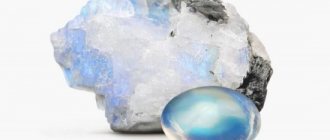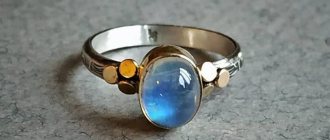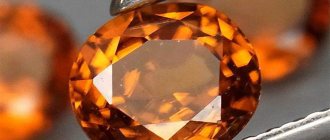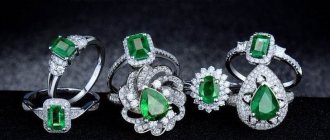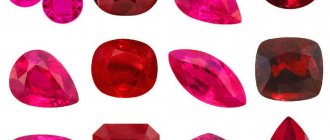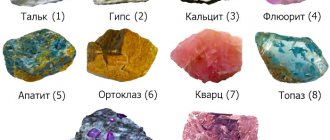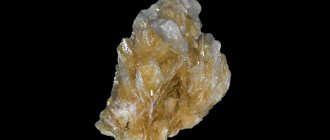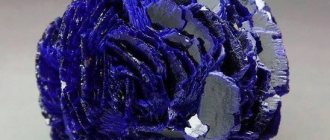| Category | Silicate minerals |
| Title in English | Adularia |
| Formula | K[AlSi3O8] |
| Group | Potassium feldspar group |
| Color | Colorless, Yellow, Light gray with a soft blue tint |
| Stroke color | White |
| Shine | Glass |
| Transparency | Translucent |
| singonia | Monoclinic |
| Hardness | 6 — 6,5 |
| Cleavage | Perfect |
| Density, g/cm³ | 2.56 - 2.62 g/cm³ |
| Kink | Uneven, Stepped |
| origin of name | The stone was named Adular in honor of the Adula mountain range, located in Switzerland. Adularia crystals were found here for the first time. But the second name of the stone - Lunar - appeared because of its blue iridescence. It is formed due to the thin-plate structure of the adularia. |
| Morphology | Moonstone crystals are prismatic, tabular or columnar. By itself, adularia is a very brittle mineral and is sensitive to shocks as well as compression. |
Adularia is also known as moonstone and orthoclase, and is a fairly rare mineral of the potassium feldspar group. It is characterized by a “cat’s eye” effect. Adularia has a fragile structure, sensitivity to impact and compression. It is often confused with chalcedony and artificial spinel.
History of the origin of adularia
The adularian got its name from the place where it was first discovered in Europe - Mount Adul in Switzerland. It was called moonstone much earlier, back in ancient times, when the mineral was discovered in India.
The ancient Hindus believed that the stone absorbs real moonlight and therefore has such an unusual white color with a blue-blue tint.
Also, mention of moonstone is found in the works of Aristotle, this speaks of the ancient history of a valuable mineral.
Where and how is adularia stone mined?
Adularia is a fairly rare mineral these days. Stones come in different shades: milky, purple and even light yellow. But the most popular ones in jewelry are bluish, they are considered a kind of standard for this mineral.
Adularia deposits are found on all continents of the planet. But it cannot be said that they are all completely similar in structure and composition. Nevertheless, mineralologists classified all gems that were as similar as possible to each other to the feldspar group.
Under the guise of adularia, they often try to sell minerals that have absolutely no value and are relatively similar in appearance to natural minerals.
The main characteristic of adularia deposits is the presence of pegmatites, ore-bearing and quartz veins. There are several places in Russia where almost transparent orthoclase, very similar to adularia, is mined:
The lunar mineral is mined in all corners of our planet.
- western side of the Kola Peninsula;
- Polar and Southern Urals (special samples with an admixture of gold and silver nanoparticles);
- Khabarovsk Territory - adularia stone has an interesting pearl tint;
- Irkutsk region - the largest specimens measuring 20 cm in size were found. Unfortunately, the quality of these giants turned out to be very low.
It is also mined on the island of Sri Lanka, where high quality moonstone was formed in ancient volcanic rock. There are mining sites in the Swiss Alps. To a lesser extent, adularia are found from India, Australia, America, and Brazil. Quite good samples are brought from the island of Madagascar, Tanzania and Burma.
Meaning
Thanks to ancient written sources that have reached the present day, one can understand the significance of moonstone in the culture of different peoples.
Thus, the ancient Greeks, Romans and Babylonians associated the mineral with the mystery and beauty, inaccessibility and coldness of the moon. The stone was believed to help with clairvoyance.
In ancient times, the peoples of the East had a special relationship with moonstone - it was sung in poetry and personified with feminine beauty and innocence. The Slavs called the stone lunar or peacock stone for its iridescent color.
Usage history
An ancient legend says that the adularia has absorbed the light of the moon for many centuries, which is why it owes such a special beauty. It is not surprising that it was highly valued and used in many cultures. In Greece, it was considered a symbol of the Moon Goddess; in ancient Babylon, adularia was used by soothsayers to enhance the gift. They put it under the tongue, believing that this would not hide the truth.
In Muslim countries, the moon is a special symbol, which is why moonstone was widely known. Its wondrous radiance was mentioned in poetry, associating it with the beauty of creation. In Europe, the lunar mineral appeared later, towards the end of the 19th century. It was used by famous jewelers in their collections, whose products can now be seen in museums. The high popularity even then gave rise to a market for counterfeits - even glass with impurities for shine was passed off as adularia.
physical characteristics
Among the physical and chemical properties of adularia there are:
- hardness on the Mohs scale – no more than 6.5 points; this indicates the fragility of the stone;
- density is approximately 2.5 grams per cubic centimeter;
- There is no transparency, but there is light transmission.
The formation of the rock occurs from silicate melts that occur in places of volcanic activity.
Physical properties
Moonstone is a potassium feldspar that is not related to the Moon.
| Physical properties | Their features |
| Formula | K[AlSi3O8] |
| Refraction | 1,520–1,525 |
| Density | 2.56–2.62 g/cm³ |
| singonia | Monoclinic. |
| Kink | Uneven, stepped. |
| Cleavage | Perfect. |
| Hardness | 6–6,5 |
| Transparency | Translucent. |
| Shine | Glass. |
| Stroke color | White. |
| Color | Light gray, with a soft blue tint, colorless, yellow. |
An optical effect occurs in the mineral; it luminesces weakly in X-rays. The lunar shimmer of the mineral is produced by transparent plate-like crystals.
Light yellow crystals are extremely rare. The highest quality gems are mined in Sri Lanka.
Varieties, colors
Selenite
Olikoglaz
Labradorite
The classic moonstone has a silvery blue color. But sometimes the shades can change, and therefore the following varieties of the mineral are distinguished:
- adularia – transparent or translucent stone of white and silver shades;
- selenite – moonstone of yellow shades;
- labradorite - a rare black mineral;
- Oligoclase - this moonstone contains blue and green crystals, which is why it acquires a rainbow color.
It is also worth considering that over time, as well as under the influence of external conditions, moonstone can change color.
Varieties
Adularia is known for its unusual shine with a “cat’s eye” effect - it shimmers when the lighting changes. Several factors influence the brightness and transparency:
- Deposit - only a few of them are a source of quality specimens.
- Amount of impurities: The higher the concentration of other substances, the cloudier the stone will be.
- Processing and grinding methods.
Adularia has no varieties, but other types of feldspar are often mistaken for moonstone. The misclassification arose due to a characteristic external property of several minerals - an iridescent glow that occurs as a reaction to bright light. Stones such as selenite, belomorite, labradorite and albite are mistaken for adularia. They are also actively used in creating jewelry, but their price should be an order of magnitude lower than that of real moonstone.
Selenite can be called a moonstone rather from an etymological point of view: its name in Greek means “stone of the moon goddess.” The external resemblance to adularia is based on soft shimmer and transparency. However, its structure is not layered; it belongs to the group of gypsum.
Selenite
Belomorite can easily be mistaken for adularia, both of which belong to the feldspar group. A slight difference in composition is manifested in the gradient of the radiance of belomorite - it shimmers with multi-colored highlights. Its hardness is lower than that of adularia, which is why jewelers do not use small crystals. The main place of belomorite mining is on the Kola Peninsula.
Labradorite stone is known for its variety of iridescence - it shimmers in different colors. The most common crystals have a blue glow; specimens with only a light blue glow can be mistakenly classified as moonstone.
Albite is a white feldspar, which is also found in the Alpine mountains, it has a white, gray, pink or yellowish tint. Polished specimens can be confused with adularia, but the glow of the latter is more pronounced.
Adularia is classified according to its deposit, which largely determines its value. One of the high-quality types is valencianite, which is mined in Mexico. Moonstone from the Czech Republic is called aglaurite; it is easily distinguished by its bluish glow. The rarest type of this mineral has a yellowish tint; strong magical properties are attributed to it.
Magic properties
Since ancient times, adularia has been valued for its magical properties. The stone serves as a love talisman and can soften the pain of separation.
Lovers who wear moonstone understand each other perfectly and rarely quarrel. If there is a cooling of feelings, then the moonstone warns about this: it changes color, darkens, and becomes dull.
Adularia is able to calm and find inner harmony. The stone also protects its owner from negative energy and from wasting energy. For women, the stone gives sexuality and natural charm.
Mysteries and legends of moonstone
Hindus call it very romantically “moonlight”.
According to legend, adularia is nothing more than the radiance of the Moon, which froze in stone. It is most popular in India and Sri Lanka. To this day, Buddhist monks believe that if you hide it from human eyes in the dark, then over time it will release a life-giving drop that has limitless healing properties. The gods Lakshmi and Vishnu received this stone as a gift from the Moon when they sailed across the sky. It was then used by the gods to create a beautiful goddess with twelve arms, called Devi.
God Shiva
The mineral was revered by the Chaldeans of Mesopotamia for its unique magical powers. Ancient Greeks in the VIII-VII centuries BC. e. It was believed that the stone was given to people by Apollo, who descends from heaven every 19 years. God puts his breath into every piece of selenite, which gives it magical properties. Such a stone awakens the powers of providence in a person.
Medicinal properties
The great value of adularia lies in its healing properties, which the stone is awarded with. It is not for nothing that moonstone has been actively used by healers and healers since ancient times.
It is believed that the stone can help with the following problems:
- depression, tension and fatigue;
- insomnia, nervousness;
- epileptic seizures, headaches;
- sharp emotional changes.
Moonstone also helps eliminate disorders of the digestive system, heart and vascular function. Significantly makes childbirth easier for women.
How to spot a fake moonstone?
Natural Adularia casts blue reflections when the stone is turned.
- Synthetics have the same shimmer no matter what angle you look at it from.
- In natural moonstone, the intensity of the glare varies depending on the angle of inclination.
- Adularia does not conduct heat well, so when touched it remains cold for some time. By the way, this property was used by ancient alchemists. Adularia thrown into boiling water instantly cools the water, in any case, this property is spoken of in various treatises.
- Natural stone is not perfect; there may be defects inside it.
- Natural adularia becomes brighter in water. Synthetics do not react to water in any way.
- It’s worth telling the truth, buying a good quality natural moonstone is a lot of luck and a lot of luck. The market is flooded with synthetics or low-grade small stones of unknown origin.
Who is suitable according to their zodiac sign?
Particular importance is given to moonstone in astrology.
Thus, the stone has a beneficial effect on the following zodiac signs:
- Cancers - for them, adularia is an ideal stone that attracts good luck and helps in financial and love affairs;
- Adularia helps slaves restore mental balance, learn to manage themselves and their emotions;
- For Scorpios, the stone is suitable for unleashing creative abilities;
- It helps Taurus relieve stress, and women of this sign help fight women’s diseases.
Moonstone is contraindicated for Aries , Capricorns and Sagittarius . The mineral relaxes representatives of this zodiac sign.
It should also be noted that if a person was born on a full moon, then, regardless of the zodiac sign, the moonstone is suitable for him.
Talismans and amulets
Jewelry with belomorite
Moonstone talismans are useful in many areas, but depending on the type of execution, their effect also changes:
- Rings, rings and bracelets worn on the right hand enhance intuition, help predict events, and contribute to the development of better personal qualities and creative potential.
- The same jewelry, worn on the left hand, balances the psyche, lifts the mood, helps avoid conflicts, find compromises and protects from ill-wishers.
- Everything that is worn on the chest or neck (pendants, beads, necklaces, brooches) is responsible for the owner’s warmth, friendliness and mercy. These amulets also attract love and help you understand your own feelings.
As the moon grows, the magical power of the lunar gem also increases. At the full moon it is at its peak, then begins to decrease.
In ancient times, they believed that men were protected by the sun, and women by the moon. Modern esotericists classify adularia as a female gem. He will make his owner more attractive and will help her more willingly than his male owner. It is for the fair sex that moonstone can become a powerful love amulet.
Moonstone Belomorite
A lunar talisman should also be acquired by creative individuals who have turned (or want to do so) their talent into work - writers, artists, musicians, painters and other creators of beauty.
All kinds of mystics (sorcerers, psychics and shamans) respect moonstone for its inexhaustible energy and ability to enhance the gift. It’s not for nothing that most of the rituals are held during the full moon.
Ancient priests and soothsayers placed a stone under their tongue. They believed that this way they could strengthen their abilities and utter the most accurate prophecy.
For ordinary people, adularia will help strengthen their intuition, teach them to predict small events and anticipate dangers.
Anyone who needs luck and luck on the verge of fantasy will also need a lunar talisman. For example, businessmen, all kinds of gentlemen of fortune, gambling enthusiasts, and so on.
Previously, this stone was considered the patron saint of sharpers and gamblers. They tried to get him at any cost, even risking their own lives.
Decorations
With its delicate, sophisticated appearance, moonstone jewelry never goes out of style. Most often, when cutting stones, a cabochon is used - a perfect oval, this allows you to get a beautiful classic piece of jewelry.
A successful combination of moonstone is with silver, since this metal does not overshadow the mineral and gives it the opportunity to shine. Adularia can be found in almost all jewelry: earrings, rings, necklaces and pendants.
Stone care
Considering the fragility of the lunar mineral, jewelers treat its surface with a cabochon - it increases the level of wear resistance. This procedure does not make the stone duller; on the contrary, the glow becomes beautifully smooth. Despite such prevention, adularia requires careful treatment; it must be removed before water procedures, especially before going to the beach. It is also not recommended to wear it in the gym, when cleaning and in bright sunlight.
To clean the adularia, use a weak soap solution at room temperature and a soft cloth. Storing a moonstone is possible only in a separate box, lined inside with velvet or other soft material. Under no circumstances should you leave the decoration with it on the tabletop or place it together with other decorations.
Price and care
Adularia itself is an inexpensive stone. Its price varies on average up to $30 per carat. If we are talking about large stones over 3 carats, the price will be about $80.
But the reserves of moonstone in its deposits are depleting, so it is quite natural that its value will increase.
Adularia is a fragile stone and, moreover, susceptible to external influences. Therefore, in addition to the traditional wiping with soapy water, periodically you need to take the jewelry to a jewelry workshop for polishing.
How to distinguish a real adularia from a fake
The highest quality samples are mined in India and Sri Lanka. But lately they have been received less and less often - the sources have simply dried up. Therefore, adularia stone is becoming much more expensive on the market, and scammers are trying harder and harder to create a high-quality fake.
In order not to fall for the tricks of scammers, it is worth remembering several special characteristics of natural material.
When the stone is rotated, a bluish pearlescent reflection appears in the light.
The peculiarity of lunar orthoclase is its iridescence when viewing the product from different angles. Refractions of light and shade are noticeable in it due to the layered structure that is characteristic of many mountain materials.
When the stone is rotated, a bluish pearlescent reflection appears in the light, which is not found in fakes. Synthetic fakes usually have an even shine at different lighting angles and greater transparency, and the bluish tone is not as bright as real moon mineral.
Another characteristic feature is keeping it cool. Natural adularia takes a long time to heat up in your hands, while ordinary glass quickly takes on body temperature.
In jewelry, artificially created stones are often used using special pressing technology. To create the desired material, adular chips are used from pieces of low-quality oligoclase. Such products have a bluish or milky tint, almost complete transparency or uniform dullness. A clear difference from natural stone is its uniform structure.
In addition, scammers often try to sell similar-looking but less expensive minerals under the guise of “moonstone”: albite, oligoclase and microcline.
What stones does it go with?
Adularia goes well with all moon stones. These are minerals such as opal, pearl, selenite, rock crystal, aquamarine, beryl, and coral. All these stones have white, silver, blue or colorless shades.
Mineral deposits
Adularia are mined in several countries:
- Sri Lanka.
- India.
- Burma.
- Australia.
- Tanzania.
- USA.
There is also a deposit on the island of Madagascar.
Russia can also boast of its reserves. In northern Karelia, as well as in the south of the Kola Peninsula, belomorites (transparent, colorless, whitish or milky stones with bright blue iridescence) are mined. The Southern Urals and Transbaikalia supply gems with silver and blue-blue iridescence.
Photo
Moon stories
In enlightened antiquity, it was believed that blue crystals shining with soft light were moonlight itself, turned into stone. The gem was credited with feminine traits: tenderness, romance, emotionality.
In Muslim families, children are traditionally loved and given birth to as many as God wills. Arab women sew a piece of moonstone into their underwear. This will help you get pregnant, Arab women firmly believe. In their opinion, the main influence of a gem on a person is to stimulate the birth of children. After all, the Moon was considered a symbol of fertility in many cultures. And it was a wonderful compliment for an Eastern woman to call her “moon-faced.”
The Indians decided that the moonlight stone was thrown out by the tides. And only in those times when the Moon and the Sun are in a harmonious relationship. And this happens once every 21 years.
From ancient times to the present day, Indians have used a crescent or lunar disk in bridal jewelry. Their magical meaning is to symbolize the purity, purity, and future fertility of the bride.
Fathers give little Indian girls jewelry with adularia, always in silver (usually crescent-shaped earrings). The combination of gem and silver is not accidental. Silver is a lunar metal.
Man, stone, fashion
Let's add limitless imagination here. And the man is Rene Lalique, jeweler; he did not disdain to work with ornamental stones and simple glass.
Lalique did the impossible - he forced women to give up diamonds for items made of simple glass. But what products they were! Almost every one of them is a classic of the 20th century. All of the master’s creations are now stored in museums or private collections. A description of the master's masterpieces will not give an idea of their beauty.
High-quality designer jewelry is always beautiful, rare and expensive.
You can write a lot about fantastic jewelry - the masterpieces of Lalique, but for us the main thing is that Rene brought the moonstone into fashion. Women fell in love with the gem, and what a woman loves, God loves. Every individual of the fair sex knows this for sure.
Interesting Facts
There have been legends about the moonstone since ancient times; there are a lot of amazing and interesting facts:
- adular is a frequent participant in magical and witchcraft rituals - this is due to its “unearthly” origin;
- during the full moon the stone brightens, and, conversely, becomes dull as it decreases;
- The scientific name of the moonstone is not so romantic - potassium aluminum trisilicate.
What is the reason for the popularity of moonstone - its mystery, romance or beauty - is unknown. But the fact that this mineral has attracted the minds of mankind for many millennia is indisputable.
Story
In the Alpine mountains, people often found transparent shimmering stones that seemed to glow with a cold and mysterious light, like the moon. The reason for this phenomenon lies in the special thin-plate structure of the mineral. It was thanks to this feature that they began to call it moonstone. The mineral received its official name “Adularia” in honor of the Adula Mountains located in the Swiss Alps.
Moon magic
The magical properties of moonstone have been spoken and written about since ancient times.
- Ancient speakers held a piece of gem in their mouth before speaking. It was believed that this helps to strengthen the gift of oratory and capture the attention of listeners.
- A talisman made from the “tears of the goddess” will protect you while traveling by land and sea.
- Moonstone is suitable for all lovers - it is romantic, like the Moon itself. For those who have lost love, an accessory with adularia (be it a ring, pendant, earrings) will help them cope with the pain of loss and find new happiness.
- An amulet made from adularia will help those who like to play in the casino. The stone stimulates intuition.
What the gem does not like is duplicity in actions and deeds.
Calculation or love
In the current mercantile age, it is difficult to understand what or who a lady feels love for - the wallet or its owner.
Good advice for owners of thick wallets. Give the lady of your heart a ring or pendant made of adularia.
Pendant with adularia
The gem has the ability to awaken emotions, compassion, and warmth towards loved ones in a woman. For a business-minded and calculating woman who has a calculator instead of a heart, this will be useful.
The magical properties of the stone, according to esotericists, will bring success in love and stimulate the intellect.
Moon phases and the magic of adularia
At the new moon, at the beginning of the first and last quarters of the moon, the properties of the stone change. At such a time, the gem is able to predict the owner’s solution to a problem and predict future events. You just need to take a pebble in your mouth, sit back comfortably and throw all thoughts out of your head. If you are afraid to keep a gem in your mouth (God forbid, you accidentally swallow it), put it under your pillow before going to bed.
Ring with moonstone
The amazing magic of the gem changes its properties in accordance with the phases of the moon. The night luminary reaches its full strength at the full moon, then weakens and at the new moon the rebirth of the night luminary occurs.
We recommend: Types and properties of GREEN QUARTZ
It's good if you ask about the future on Monday. This day is dedicated to the Moon.
Interesting: magicians believe that the soul of a person born on a new moon is free from karmic sins.
On a full moon, the gem helped quarreling lovers reconcile.
Show me the moon
If we talk about stones closely associated with the Moon, we need to talk about the gem.
Adularia and Selenite are patronized by the full, white Moon. On a full moon, be sure to place these minerals under the light of the moon. “Moon baths” are necessary to restore the magical powers of gems. Only under the light of the full moon do they “gain strength” and generously give their owner their strength.
Many players consider the gem to be their talisman and are confident that the stone helps read information.
By the way, if you go to play in Monte Carlo, take a “charged” moonstone with you. You won't be a loser.
Ring with adularia
Labradorite is a Dark Moon stone.
Labrador requires “moon baths” during the new moon. The magic of lunar rebirth will charge Labrador. But not everyone can handle this stone, and not everyone needs it. Labradorite facilitates not only communication with the souls of departed people, but also with the spirits of the lower astral plane. Roughly speaking, you can not only communicate with the spirit of your beloved aunt, but also attach a larv to yourself. Then you will start running around among psychics and grandmothers, trying to find out who caused the damage. But there is no damage. If you don’t know how to protect yourself from this, wear your Labrador more carefully.
If you practice spiritualism, necromancy, black magic, this is your gem.
Unverified: priests of temples in India claim that a crystal of moonstone lying in the dark begins to release moisture called moon dew. She has enormous magical power.
